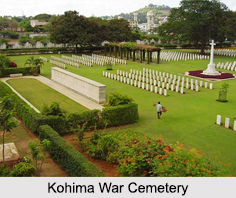 Located in the centre of Kohima city in the state of Nagaland, the Kohima War Cemetery is a memorial dedicated to the soldiers of the 2nd British Division of the Allied Forces. These soldiers gave their lives during the Second World War, forcing the Japanese army to retreat.
Located in the centre of Kohima city in the state of Nagaland, the Kohima War Cemetery is a memorial dedicated to the soldiers of the 2nd British Division of the Allied Forces. These soldiers gave their lives during the Second World War, forcing the Japanese army to retreat.
History of Kohima War Cemetery
In March 1944, the Japanese troops advanced into India and attacked the British troops stationed in Kohima. But their attacks and advances were halted in April 1944 when the Japanese troops reached Kohima. The Japanese 15th army occupied a strategic location on Garrison Hill and continually attacked a small contingent of the Commonwealth forces. They were successful in holding their ground until reinforcements were brought in.
In the battle at the tennis ground of the Deputy Commissioner`s bungalow, which also involved physical combat between the opposing forces, the Commonwealth forces prevailed over the Japanese forces and forced them to retreat in defeat. There were heavy casualties on both sides. This battle is considered as "Britain"s Greatest Battle" and is often referred to as the "Stalingrad of the East". The Kohima War Cemetery was established in the year 1946 on the slopes of the Garrison Hill as a memorial dedicated to 1420 Commonwealth soldiers along with 917 Hindu and Sikh soldiers who laid their lives while halting Japanese advance into India.
Structure of Kohima War Cemetery
The Kohima War Cemetery is laid out on what were the terraced lawns of the British Deputy Commissioner"s bungalow. Some of the most brutal fighting took place across the tennis court near the top, where the white marker lines are still in place. The cemetery is located at the exact location where the war was fought and is set in a peaceful surrounding with well manicured grassland, where roses bloom in season.
The cemetery is marked at its two ends by tall, concrete structures engraved with the cross. The memorial cross at the upper end part is located at the highest end of the cemetery. It commemorates the names of the Hindu and Sikh soldiers, who were part of the British Indian Army and died on the battlefield.
The lower end memorial is dedicated to the second Division. It is a 15 ft tall, massive stone fixed over a dressed stone platform. This stone was originally located on a spur at Maram, to the south of Kohima, which was then shifted with the help of Naga people to be erected at the second British Division`s war cemetery. While the top part of the memorial is marked with a cross, at the lower part lays a bronze plate that carries an epitaph.
Between these two structures, along the sloping ground is a series of terraces of 3 to 5 metres in height that have been created. These contain stone markers embedded with bronze plaques carrying the name of each Commonwealth soldier who died on the Kohima battlefield. These markers are made distinctly visible by a white wash.
Recently in the years 2005 and 2015, the 60th and 70th anniversary of the end of the World War II were celebrated respectively. A memorial service was held for both the occasions and was attended by senior British officers.
Visiting Information on Kohima War Cemetery
The Kohima War Cemetery is situated on the northern side of the Imphal- Dimapur road on State Highway 39 about 200 km away from the Indo- Burma border. The nearest railway station and airport are at Dimapur at a distance of 73 km and 67 km respectively.



















